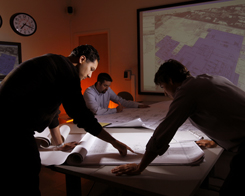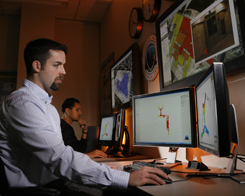NEWS RELEASES
FOR IMMEDIATE RELEASE
March 13, 2008
Sandia's BioWatch Indoor Reachback Center contributing to Department of Homeland Security effort
Capability established to provide scientific modeling support to decision-makers responding to a bioterrorism event

Sandia researchers Nerayo Teclemariam, Nate Gleason, and David Franco (left to right) review facility plans from a major U.S. airport. Such materials, combined with decades of research, help BIRC team members make accurate predictions for facility owners that can help secure and protect their buildings. (Photo by Randy Wong)
Download 300dpi 11MB JPEG image (Media are welcome to download/publish this image with related news stories.)
LIVERMORE, CALIF. —Say you’re an emergency response manager for a high-profile transportation facility. Among other responsibilities, you’re charged with overseeing the biodetection system at your facility and knowing how to respond if a detector goes off.
What if said detectors do, indeed, sound an alarm, suggesting something may be amiss? What’s your next move?
If the BioWatch Indoor Reachback Center (BIRC) continues to develop at its current pace, you might just pick up the phone and speak with a Sandia National Laboratories employee.
Since August of last year, a small group of Sandia/California researchers have been operating BIRC. It’s part of the Department of Homeland Security’s BioWatch program, an early warning system designed to rapidly detect trace amounts of biological materials at various public facilities across the United States. BioWatch assists public health experts to determine the presence and geographic extent of a biological agent release, allowing federal, state, and local officials to more quickly determine emergency response, medical care and consequence management needs.
BIRC’s role, says principal investigator Nate Gleason, is to provide scientific modeling support to decisionmakers responding to a public release of a biohazard agent. “Our goal is have a positive impact on the first response to such an attack,” says Gleason.
Sandia is a National Nuclear Security Administration laboratory.
BIRC team provides quick turnaround, key insights
BIRC is prepared to deliver information to decisionmakers (typically, the emergency response personnel at high-traffic transportation facilities) within two hours of notification of a biohazard release. The information includes important issues such the size and location of the release and recommendations as to where sampling efforts should be focused. The BIRC can also offer insight into whether the release is merely environmental in nature, or intentional, for example a terrorist attack.
A key component of BIRC is a database that contains hundreds of thousands of possible attack scenarios. When facility managers contact Sandia to report a biohazard release, researchers immediately tap into the software’s vast library to help determine the most likely scenarios. As additional information from the event becomes available — from sampling, for example — predictions can be refined after taking the new data into account. Gleason wrote the code that serves as the software’s framework, while Sandia computer scientist Ann Yoshimura developed the visualization software.

As part of their analysis for BIRC, Sandia researchers like Nate Gleason (foreground), have access to a vast database that contains hundreds of thousands of possible attack scenarios. “Our goal is have a positive impact on the first response to an attack,” says Gleason. (Photo by Randy Wong)
Download 300dpi 11MB JPEG image (Media are welcome to download/publish this image with related news stories.)
The Sandia researchers involved in BIRC have access to detailed models, plans and schematics for a handful of major transportation facilities (BioWatch involves some 30 facilities from across the country). These materials, combined with decades of research and collaborative efforts with such venues as San Francisco International Airport, the Washington Metropolitan Area Transportation Authority, and other high-profile transportation hubs, help Sandia researchers make accurate predictions for facility owners that can help secure and protect their buildings.
“When a biohazard event occurs and a detector alarms, the response by facility managers is dependent upon a number of factors and key pieces of information,” says Gleason. “They need to know the source and intensity of the contamination. They need to know which parts of the facilities are likely contaminated, and which ones aren’t. BIRC is able to provide this kind of information.”
In addition, Gleason says, BIRC makes it easier for facility managers to determine whether released organisms are infectious or not. Though BIRC does not provide public health advice or information on specific organisms, it can specify where in the facility samples of the organism can be located for testing.
BROOM, understanding of facilities provide backbone for success
Sandia’s unique understanding of facilities, says Gleason, and the fast and accurate reconstruction of the event can help managers make more informed decisions about what to do.
A recently added component of BIRC is Sandia’s own Building Restoration Operations Optimization Model (BROOM) technology. BROOM is a handheld, software-based restoration and decontamination tool that contains building maps and other information to simplify tracking and sample collection in a contaminated area. Surface sampling results transmitted to BIRC can be input into BROOM, an approach that leads to more accurate contamination maps and more certain predictions.
BIRC’s resources are also available to regional BioWatch jurisdictions to support planning and exercise activities.
Among BIRC’s future goals is to develop an electronic “playbook” of sorts following a biohazard event that gives participating facilities even more useful information, such as step-by-step advice and recommendations on how facilities might respond appropriately or integrate BIRC information with their own response plans.
Sandia is a multiprogram laboratory operated by Sandia Corporation, a Lockheed Martin company, for the U.S. Department of Energy’s National Nuclear Security Administration. With main facilities in Albuquerque, N.M., and Livermore, Calif., Sandia has major R&D responsibilities in national security, energy and environmental technologies, and economic competitiveness.
Sandia news media contact: Mike Janes, mejanes@sandia.gov, (925) 294-2447